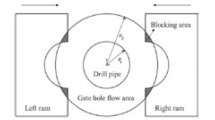Abstract
The performance of the air-trapping mechanism to suppress sloshing impact pressure in a prismatic tank was numerically evaluated. In order to implement the air-trapping mechanism, a short horizontal baffle array was installed on either side of the tank to collect air by the sloshing flow. The impact pressure change was analyzed by setting the ratio of the baffle length to the tank width as a parameter, and the pressure distribution on the wall was observed through eight calculation points (CPs) set between the baffles in the direction of tank height. The suppression performance of impact pressure was evaluated using Eulerian- Eulerian multiphase model to consider the water-air two-phase flow. The visualization results show the generation of sloshing impact pressure and the effects of the air-trapping mechanism. Quantitative comparisons of time series results of pressure were performed using peak pressure comparison and fast Fourier transform (FFT) analysis. The overall sloshing impact pressure reduction was 58.2 % in the FFT analysis and the maximum reduction rate was 70.4 %.
Similar content being viewed by others
References
H. Kim, N. Parthasarathy, Y. H. Choi and Y. W. Lee, Reduction of sloshing effects in a rectangular tank through an air-trapping mechanism — A numerical study, Journal of Mechanical Science and Technology, 32(3) (2018) 1049–1056.
H. Kim, Y. H. Choi and Y. W. Lee, Numerical analysis of sloshing impact in horizontally excited prismatic tanks, Progress in Computational Fluid Dynamics, 17(6) (2017) 361–367.
H. Kim, M. K. Dey, N. Oshima and Y. W. Lee, Numerical study on sloshing characteristics with Reynolds number variation in a rectangular tank, Computation, 6(4) (2018) 53.
W. Wang, Z. Guo, Y. Peng and Q. A. Zhang, Numerical study of the effects of the T-shaped baffles on liquid sloshing in horizontal elliptical tanks, Ocean Engineering, 111 (2016) 543–568.
W. Wang, Y. Peng, Y. Zhou and Q. Zhang, Liquid sloshing in partially-filled laterally-excited cylindrical tanks equipped with multi baffles, Applied Ocean Research, 59 (2016) 543–563.
K. C. Biswal and S. K. Bhattacharyya, Dynamic response of structure coupled with liquid sloshing in a laminated composite cylindrical tank with baffle, Finite Elements in Analysis and Design, 46(11) (2010) 966–981.
J. R. Cho, H. W. Lee and S. Y. Ha, Finite element analysis of resonant sloshing response in 2-D baffled tank, Journal of Sound and Vibration, 288(4–5) (2005) 829–845.
D. Zhou, J. D. Wang and W. Q. Liu, Nonlinear sloshing of liquid in rigid cylindrical container with a rigid annular baffle: Free vibration, Nonlinear Dynamics, 78(4) (2014) 2557–2576.
S. Rebouillat and D. Liksonov, Fluid-structure interaction in partially filled liquid containers: A comparative review of numerical approaches, Computers & Fluids, 39(5) (2010) 739–746.
D. H. Lee, M. H. Kim, S. H. Kwon, J. W. Kim and Y. B. Lee, A parametric sensitivity study on LNG tank sloshing loads by numerical simulations, Ocean Engineering, 34(1) (2007) 3–9.
D. W. Fox and J. R. Kuttler, Sloshing frequencies, Zeitschrift für angewandte Mathematik und Physik (ZAMP), 34(5) (1983) 668–696.
Acknowledgments
This work was supported by“Human Resources Program in Energy Technology” of the Korea Institute of Energy Technology Evaluation and Planning (KETEP), granted financial resource from the Ministry of Trade, Industry & Energy, Republic of Korea. (No. 20184010201700) and by a National Research Foundation of Korea (NRF) grant funded by the Korean Government (MSIT) (NRF-2019R1F1A1062140).
Author information
Authors and Affiliations
Corresponding author
Additional information
Recommended by Editor Yang Na
Hyunjong Kim received his master’s (2014) and bachelor’s (2012) degree in Engineering from the Department of Mechanical Engineering, Pukyong National University, Korea. He received his Ph.D. (2018) in Mechanical Engineering from Pukyong National University, Korea. Currently, he is a Post-doctoral fellow at the Korea Atomic Energy Research Institute (KAERI), Daejon, Korea. His research interests are two-phase flows and CFD applications.
Nanjundan Parthasarathy received his master’s degree (2000) in Mathematics from Bharathiar University, India. From 2000 to 2010, he had worked as Lecturer in Mathematics in India. He received his Ph.D. (2017) in Mechatronics Engineering from Pukyong National University, Korea. Currently, he is a Post-doctoral fellow at the Research Institute of Science and Technology, Pukyong National University, Korea. His research interests are renewable energy problems, sloshing dynamics and CFD applications.
Junho Jeon received his master’s degree (2016) in Mechanical Design Engineering from Pukyong National University, Korea. Currently, he is on a doctoral program in Mechanical Design Engi-neering from Pukyong National Univer-sity, Korea. His research interests are power plant systems and CFD applications.
Yeon Won Lee received his master’s and bachelor’s degrees in Mechanical Engineering at the KyungPook National University, Korea. He worked as an Engineer at the POSCO Engineering Company for three years. He received his Ph.D. in Turbulence Modeling and Numerical Methods in 1993 from the University of Tokyo. Since 1993, he has been a Professor at the School of Mechanical Engineering, Pukyong National University, Korea. His research interests are wave energy, heat transfer, thermal fluid system design and CFD applications.
Rights and permissions
About this article
Cite this article
Kim, H., Nanjundan, P., Jeon, J. et al. Numerical estimation on applying air-trapping mechanism to suppress sloshing loads in a prismatic tank. J Mech Sci Technol 34, 2895–2902 (2020). https://doi.org/10.1007/s12206-020-0621-6
Received:
Revised:
Accepted:
Published:
Issue Date:
DOI: https://doi.org/10.1007/s12206-020-0621-6




